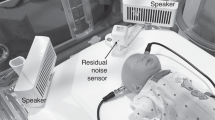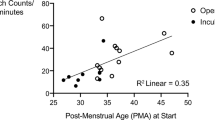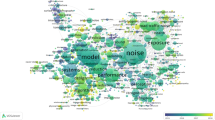Abstract
Background:
Excessive noise in neonatal intensive care units (NICUs) can interfere with infants’ growth, development and healing.
Local problem:
Sound levels in our NICUs exceeded the recommended levels by the World Health Organization.
Methods:
We implemented a noise reduction strategy in an urban, tertiary academic medical center NICU that included baseline noise measurements. We conducted a survey involving staff and visitors regarding their opinions and perceptions of noise levels in the NICU. Ongoing feedback to staff after each measurement cycle was provided to improve awareness, engagement and adherence with noise reduction strategies. After widespread discussion with active clinician involvement, consensus building and iterative testing, changes were implemented including: lowering of equipment alarm sounds, designated ‘quiet times’ and implementing a customized education program for staff.
Interventions:
A multiphase noise reduction quality improvement (QI) intervention to reduce ambient sound levels in a patient care room in our NICUs by 3 dB (20%) over 18 months.
Results:
The noise in the NICU was reduced by 3 dB from baseline. Mean (s.d.) baseline, phase 2, 3 and 4 noise levels in the two NICUs were: LAeq: 57.0 (0.84), 56.8 (1.6), 55.3 (1.9) and 54.5 (2.6) dB, respectively (P<0.01). Adherence with the planned process measure of ‘quiet times’ was >90%.
Conclusions:
Implementing a multipronged QI initiative resulted in significant noise level reduction in two multipod NICUs. It is feasible to reduce noise levels if QI interventions are coupled with active engagement of the clinical staff and following continuous process of improvement methods, measurements and protocols.
This is a preview of subscription content, access via your institution
Access options
Subscribe to this journal
Receive 12 print issues and online access
$259.00 per year
only $21.58 per issue
Buy this article
- Purchase on Springer Link
- Instant access to full article PDF
Prices may be subject to local taxes which are calculated during checkout


Similar content being viewed by others
References
Marlow N, Wolke D, Bracewell MA, Samara M . Neurologic and developmental disability at six years of age after extremely preterm birth. N Engl J Med 2005; 352 (1): 9–19.
Perlman JM . Neurobehavioral deficits in premature graduates of intensive care—potential medical and neonatal environmental risk factors. Pediatrics 2001; 108 (6): 1339–1348.
American Academy of Pediatrics. Committee on Environmental Health. Noise: a hazard for the fetus and newborn. Pediatrics 1997; 100 (4):724–727.
Committee on Environmental Hazards. Noise pollution: neonatal aspects. Pediatrics 1974; 54 (4):476–479.
Long JG, Lucey JF, Philip AG . Noise and hypoxemia in the intensive care nursery. Pediatrics 1980; 65 (1): 143–145.
Anderssen SH, Nicolaisen RB, Gabrielsen GW . Autonomic response to auditory stimulation. Acta Paediatr 1993; 82 (11): 913–918.
Gerhardt KJ, Pierson LL, Huang X, Abrams RM, Rarey KE . Effects of intense noise exposure on fetal sheep auditory brain stem response and inner ear histology. Ear Hear 1999; 20 (1): 21–32.
Gadeke R, Doring B, Keller F, Vogel A . The noise level in a childrens hospital and the wake-up threshold in infants. Acta Paediatr Scand 1969; 58 (2): 164–170.
Gerber SE, Lima CG, Copriviza KL . Auditory arousal in preterm infants. Scand Audiol Suppl 1983; 17: 88–93.
Aaron JN, Carlisle CC, Carskadon MA, Meyer TJ, Hill NS, Millman RP . Environmental noise as a cause of sleep disruption in an intermediate respiratory care unit. Sleep 1996; 19 (9): 707–710.
Little A, Ethier C, Ayas N, Thanachayanont T, Jiang D, Mehta S . A patient survey of sleep quality in the intensive care unit. Minerva Anestesiol 2012; 78 (4): 406–414.
Wright NE, Thislethwaite D, Elton RA, Wilkinson EM, Forfar JO . The speech and language development of low birth weight infants. Br J Disord Commun 1983; 18 (3): 187–196.
Graven SN . Sound and the developing infant in the NICU: conclusions and recommendations for care. J Perinatol 2000; 20 (8 Pt 2): S88–S93.
Berglund B, Lindvall T, Schwela DH. Guidelines for Community Health. World Health Organization: Geneva, 1999..
Gerhardt KJ, Abrams RM . Fetal exposures to sound and vibroacoustic stimulation. J Perinatol 2000; 20 (8 Pt 2): S21–S30.
Gerhardt KJ, Abrams RM, Oliver CC . Sound environment of the fetal sheep. Am J Obstet Gynecol 1990; 162 (1): 282–287.
American Academy of Pediatrics and The American College of Obstetricians and Gynecologists. Guidelines for Perinatal Care, 7th edn. American Academy of Pediatrics, 2012..
Anagnostakis D, Petmezakis J, Messaritakis J, Matsaniotis N . Noise pollution in neonatal units: a potential health hazard. Acta Paediatr Scand 1980; 69 (6): 771–773.
Almadhoob A, Ohlsson A . Sound reduction management in the neonatal intensive care unit for preterm or very low birth weight infants. Cochrane Database Syst Rev 2015; 1: CD010333.
Blomkvist V, Eriksen CA, Theorell T, Ulrich R, Rasmanis G . Acoustics and psychosocial environment in intensive coronary care. Occup Environ Med 2005; 62 (3): e1.
McNeer RR, Bennett CL, Dudaryk R . Intraoperative noise increases perceived task load and fatigue in anesthesiology residents: a simulation-based study. Anesth Analg 2016; 122 (2): 512–525.
Ramesh A, Suman Rao PN, Sandeep G, Nagapoornima M, Srilakshmi V, Dominic M et al. Efficacy of a low cost protocol in reducing noise levels in the neonatal intensive care unit. Indian J Pediatr 2009; 76 (5): 475–478.
Plan-Do-Study-Act (PDSA) worksheet (IHI tool), 2012..
Park M, Kohlrausch A, de Bruijn W, de Jager P, Simons K . Analysis of the soundscape in an intensive care unit based on the annotation of an audio recording. J Acoust Soc Am 2014; 135 (4): 1875–1886.
Domanico R, Davis DK, Coleman F, Davis BO . Documenting the NICU design dilemma: comparative patient progress in open-ward and single family room units. J Perinatol 2011; 31 (4): 281–288.
Wang D, Aubertin C, Barrowman N, Moreau K, Dunn S, Harrold J . Examining the effects of a targeted noise reduction program in a neonatal intensive care unit. Arch Dis Child Fetal Neonatal Ed 2014; 99 (3): F203–F208.
Lahav A . Questionable sound exposure outside of the womb: frequency analysis of environmental noise in the neonatal intensive care unit. Acta Paediatr 2015; 104 (1): e14–e19.
Lombard E . Le signe de l'elevation de la voix. Annales Des Maladies de L'Orielle et Du Larynx 1911; 37: 101–119.
Lasky RE, Williams AL . Noise and light exposures for extremely low birth weight newborns during their stay in the neonatal intensive care unit. Pediatrics 2009; 123 (2): 540–546.
Wachman EM, Lahav A . The effects of noise on preterm infants in the NICU. Arch Dis Child Fetal Neonatal Ed 2011; 96 (4): F305–F309.
Chaudhari S . Neonatal intensive care practices harmful to the developing brain. Indian Pediatr 2011; 48 (6): 437–440.
Krueger C, Schue S, Parker L . Neonatal intensive care unit sound levels before and after structural reconstruction. MCN Am J Matern Child Nurs 2007; 32 (6): 358–362.
Abdeyazdan Z, Ghassemi S, Marofi M . The effects of earmuff on physiologic and motor responses in premature infants admitted in neonatal intensive care unit. Iran J Nurs Midwifery Res 2014; 19 (2): 107–112.
Abou Turk C, Williams AL, Lasky RE . A randomized clinical trial evaluating silicone earplugs for very low birth weight newborns in intensive care. J Perinatol 2009; 29 (5): 358–363.
Acknowledgements
We thank family members and hospital staff who participated in the survey and helped in the successful implementation of strategies over time to reduce the noise level in our NICUs. We are very thankful to Debbie Mathoney, Kathleen McLaughlin, Laronda Gracia-Allen, Linda Grundy, Shelley Hendel, Brande Mazzeo, Pamela J Graham, Jeanette Farris, Kimberly Roman, Lori Witt, Stephanie Hoover and Jennie Basirico for their help in the successful implementation of the QI initiative. We thank Dr Steven E Lipshultz for critically reviewing the manuscript and his suggestions.
Author information
Authors and Affiliations
Corresponding author
Ethics declarations
Competing interests
The authors declare no conflict of interest.
Rights and permissions
About this article
Cite this article
Chawla, S., Barach, P., Dwaihy, M. et al. A targeted noise reduction observational study for reducing noise in a neonatal intensive unit. J Perinatol 37, 1060–1064 (2017). https://doi.org/10.1038/jp.2017.93
Received:
Revised:
Accepted:
Published:
Issue Date:
DOI: https://doi.org/10.1038/jp.2017.93
This article is cited by
-
Cochrane Pflegeforum
ProCare (2022)
-
Effect of a light-darkness cycle on the body weight gain of preterm infants admitted to the neonatal intensive care unit
Scientific Reports (2022)
-
Impacts of Personalized Sensor Feedback Regarding Exposure to Environmental Stressors
Current Pollution Reports (2021)
-
Neonatal intensive care unit incubators reduce language and noise levels more than the womb
Journal of Perinatology (2020)
-
Noise Reduction Based on Training Intervention and Using Visual Signs in Neonatal Intensive Care Units (NICUs)
Acoustics Australia (2020)



